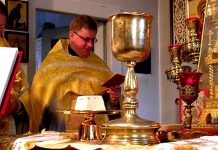Jesus’ genealogy appears in two places in the New Testament: Matthew 1:1-17 and Luke 3:23-38. In Matthew, Jesus’ genealogy is presented in a descending order: it goes from Abraham to Joseph. In Luke, Jesus’ genealogy is in an ascending order: it goes from Joseph to Adam.
Both genealogies are given, not to emphasize biological connection, but to emphasize that Jesus is the fulfillment of God’s purpose of redemption. The focus of the genealogies is theological. The genealogy of Jesus is designed to show that Jesus is the Messiah, a descendant of David, and a descendant of Abraham.
As a descendant of Abraham, Jesus fulfills God’s covenantal promise to Abraham. God promised Abraham that he would be a blessing to the nations: “in you all the families of the earth shall be blessed” (Genesis 12:3).
As a descendant of David, Jesus fulfills God’s covenantal promise to David. God promised David that his throne would be established forever (2 Samuel 7:16). According to David, God also promised him that a successor will always be available to sit on the throne of Israel (1 Kings 2:4).
Since the monarchy ended with the Fall of Jerusalem in 587 B.C., as a descendant of David, Jesus becomes an inheritor of God’s promise to David. As such, Jesus’ genealogy proves that he was a direct descendant of David and a legitimate heir to the throne.
Matthew’s genealogy is the only one that makes reference to four women in Jesus’ family tree: Tamar, Rahab, Ruth, and Bathsheba. Bathsheba’s name is not explicitly mentioned by Matthew; she is only identified as Uriah’s wife. A fifth woman, Mary, is mentioned by name. However, since she is a New Testament personality, Mary falls outside of the purview of the Old Testament because she was not one of Jesus’ great-grandmothers.
The genealogy of Jesus in the Gospel of Matthew is divided into three groups, each consisting of fourteen generations (Matthew 1:17). In an upcoming post I will have more to say about the fourteen generations.
The purpose of today’s post is to briefly study the four women mentioned in Jesus’ genealogy. After identifying them and looking at some aspects of their lives, I will try to ascertain the reasons Matthew included their names in Jesus’ genealogy.
Tamar: A Great-Grandmother of Jesus
The first woman listed in Matthew’s genealogy is Tamar: “Judah the father of Perez and Zerah by Tamar” (Matthew 1:3).
The story of Tamar is found in Genesis 38. The story of Tamar is a story of love, betrayal, and righteousness. Tamar was the wife of Er, Judah’s oldest son. Judah married a Canaanite woman and had three sons by her: Er, Onan, and Shelah. Judah found a wife for Er. Her name was Tamar. The text does not specify whether Tamar was a Hebrew or a Canaanite woman. However, it is clear from the context that she was a Canaanite woman.
For some unknown reason, the Bible says that “Er, Judah’s firstborn, was wicked in the sight of the LORD, and the LORD put him to death” (Genesis 38:7). So, Judah told Onan, his second-born son, to take Tamar and perform the duty of Levirate. In Levirate marriage, a brother of a deceased man marries his brother’s widow in order to raise up an offspring for the deceased brother.
Onan, however, did not want to give Tamar a son. So, whenever he had sexual relations with Tamar, he would spill his semen on the ground. His action “was displeasing in the sight of the LORD, and he put him to death also” (Genesis 38:8-10). Judah then told Tamar to remain a widow until Shelah grew up. However, Judah never intended to give Shelah to Tamar for fear that Shelah also would die.
Since Judah refused to fulfill his promise, Tamar disguised herself as a prostitute, came to the road leading to the city of Enaim and sat at the entrance of the city. When Judah came, he solicited her for sex. Tamar became pregnant and when Judah threatened to kill her, Tamar revealed that Judah was the man who had impregnated her. Judah acknowledged that he was the father and said, “She is more in the right than I, since I did not give her to my son Shelah” (Genesis 38:26). Tamar became the mother of twin sons. The first son was named Perez and the second was named Zerah.
Rahab: A Great-Grandmother of Jesus
The second woman listed in Matthew’s genealogy is Rahab: “Salmon the father of Boaz by Rahab” (Matthew 1:5).
Rahab’s story appears in Joshua 2. She was the prostitute that protected the two spies who secretly entered Jericho on the eve of Israel’s conquest of the land. When the king of Jericho heard that the spies had come to her house, the king ordered Rahab to surrender the men to him.
However, Rahab had heard that the Lord had delivered Israel from their oppression in Egypt and how he was planning to give the land of Canaan to Israel. For this reason, Rahab promised to protect the two men if they promised to spare her and her family when they conquered the city.
When Israel entered the land and conquered Jericho, Joshua and the army of Israel spared Rahab and her family, and all that belonged to her. According to Matthew’s genealogy, Rahab married a man from Judah and she became the mother of Boaz.
Ruth: A Great-Grandmother of Jesus
The third woman listed in Matthew’s genealogy is Ruth: “Boaz the father of Obed by Ruth” (Matthew 1:5).
The story of Ruth occurred in the days of the Judges. Because of a great famine in Israel, an Ephrathite man from Bethlehem of Judah named Elimelech and his wife Naomi left their land and went to find a better life in Moab. This couple had two sons, Mahlon and Chilion. These two men married Moabite women. Mahlon’s wife was Ruth and Chilion’s wife was named Orpah.
Eventually Elimelech and his two sons died in Moab and Naomi was left a widow and without her two sons. When Naomi decided to return to Bethlehem, Ruth decided to go with her. Upon their return, Ruth began gleaning in the fields of Boaz.
At the end of the harvest, Naomi told Ruth to go where Boaz was sleeping. She came where he was and laid down beside him. In the morning Boaz discovered that he had the right to redeem Naomi and Ruth as her next-of-kin. After Boaz exercised his right of redemption, Boaz married Ruth and they became the parents of Obed and Ruth became the great-grandmother of David.
Bathsheba: A Great-Grandmother of Jesus
The fourth woman listed in Matthew’s genealogy is Bathsheba: “David was the father of Solomon by the wife of Uriah” (Matthew 1:6).
Although Bathsheba appears in Matthew’s genealogy as “the wife of Uriah,” she plays an important role in David’s life and in the genealogy of Jesus. Bathsheba’s story appears in 2 Samuel 11-12.
Bathsheba was married to Uriah, one of the mighty warriors in David’s army. While Uriah and the army of Israel were fighting a war against the Ammonites, David had remained in Jerusalem. When David saw Bathsheba bathing, he lusted after her because she was “very beautiful” (2 Samuel 11:2). David had sex with Bathsheba and she became pregnant.
When David heard that Bathsheba was with child, he devised a plan to convince Uriah to come home and lie with his wife so that the pregnancy could be attributed to Uriah’s relationship with his wife. When the plan failed, David made plans to put Uriah in the forefront of the battle so that he could die by the hands of the Ammonites.
After Uriah’s death, David married Bathsheba and she gave birth to her child. Soon after the child was born, the child died. David and Bathsheba had another child, Solomon. Solomon became king of Israel after David’s death. As a result of David’s marriage to Bathsheba, every king of Judah after David became a descendant of Bathsheba.
Jesus’ Great-Grandmothers in Matthew’s Genealogy
Over the years, scholars have asked the reason Matthew included these four women in the genealogy of Jesus. One traditional answer is that these four women were sinners. This view affirms that Jesus was born to save sinners and the four women are used to prove this truth.
Others have said that these four women serve as a contrast to Mary, who was sinless. This view is an attempt to affirm that Mary was a virgin when Jesus was conceived and to address the view that Jesus was an illegitimate child.
Some scholars have suggested that these women were included in Jesus’ genealogy because they were Gentile women, thus emphasizing that Jesus came to save Jews and Gentiles.
I think these views have some truth in them. However, Matthew’s emphasis that Jesus is the Messiah and that he is the son of David and the son of Abraham indicates that he was trying to present the universality of Jesus’ work. The inclusion of these four Gentile women is an important component of the message Matthew sought to communicate with his gospel.
Since Matthew divides Jesus’ genealogies into three groups of fourteen generations, there were many other women whose names were not included in the genealogy that appears in Matthew. These unnamed great-grandmothers of Jesus also deserve some recognition.
In my next post I will mention some of the other great-grandmothers of Jesus that Matthew failed to mention in his genealogy.
Claude Mariottini
Professor of Old Testament
Northern Baptist Seminary
NOTE: Did you like this post? Be sure to click the “Like” button and then share this post on Facebook, and tweet it on Twitter! I would love to hear from you! Let me know what you thought of this post by leaving a comment below. Be sure to like my page on Facebook, follow me on Twitter, and subscribe to my blog to receive each post by email.
Posts on Jesus’ Great-Grandmothers:
1. Jesus’ Great-Grandmothers
2. The Other Great-Grandmothers of Jesus
3. Jezebel, A Great-Grandmother of Jesus
4. The Genealogy of Jesus According to His Great-Grandmothers
claudemariottini.com
The legend of St. Ismeria marks a shift in belief, as sanctity was previously more often earned by blood martyrdom rather than piety. | © History
Jesus’ great-grandmother identified. Learn more about Jesus’ great-grandmother in this article.
THE GIST
– According to medieval manuscripts, the great-grandmother of Jesus was St. Ismeria.
– The legend of St. Ismeria emphasizes sanctity earned by a life of penitence as opposed to blood martyrdom.
– St. Ismeria likely served as a role model for older women during the 14th and 15th centuries.
The great-grandmother of Jesus was a woman named Ismeria, according to Florentine medieval manuscripts analyzed by a historian.
The legend of St. Ismeria, presented in the current Journal of Medieval History, sheds light on both the Biblical Virgin Mary’s family and also on religious and cultural values of 14th-century Florence.
SLIDE SHOW: The Shroud of Turin Throughout History
“I don’t think any other woman is mentioned” as Mary’s grandmother in the Bible, Catherine Lawless, author of the paper, told Discovery News. “Mary’s patrilineal lineage is the only one given.”
“Mary herself is mentioned very little in the Bible,” added Lawless, a lecturer in history at the University of Limerick. “The huge Marian cult that has evolved over centuries has very few scriptural sources.”
Lawless studied the St. Ismeria story, which she said has been “ignored by scholars,” in two manuscripts: the 14th century “MS Panciatichiano 40” of Florence’s National Central Library and the 15th century “MS 1052” of the Riccardiana Library, also in Florence.
SEE ALSO: Oldest Portraits Of Apostles Found
“According to the legend, Ismeria is the daughter of Nabon of the people of Judea, and of the tribe of King David,” wrote Lawless. She married “Santo Liseo,” who is described as “a patriarch of the people of God.” The legend continues that the couple had a daughter named Anne who married Joachim. After 12 years, Liseo died. Relatives then left Ismeria penniless.
“I’m pretty sure one is supposed to believe that it was either her dead husband’s relatives or, less likely, her natal family,” Lawless said. “The family of the Virgin Mary would not have been cast in such a light.”
Ismeria then goes to a hospital where she finds refuge. She is said to perform a miracle, filling a shell with fish to feed all of the hospital’s patients. After this miracle she prays to be taken away from the “vainglory of this world.”
WATCH VIDEO: Leonardo da Vinci used mirrors to hide biblical images in his most famous masterpieces.
After God called her to “Paradise,” a rector at the hospital informed the Virgin Mary and Jesus of her passing. They departed for the hospital with the 12 Apostles, Mary Magdalene, Mary Salome and Mary Cleophas. There they paid honor to St. Ismeria.
The legend marks a shift in belief, as sanctity was previously more often earned by blood martyrdom rather than piety. Lawless credits that, in part, to the rise in the belief of Purgatory, an interim space between heaven and hell where sins could be purged.
“The more sins purged in one’s lifetime (through penitence, good works, etc.) the less time needed in purgatory — for either oneself or one’s family,” she said.
She also pointed out that “the great bulk of Christian martyrs of the west died under the Roman persecutions, which ended in the fourth century.”
SEE ALSO: Moses’ Red Sea Parting Explained by Computer Model
While the author of the Ismeria legend remains unknown, Lawless thinks it could have been a layperson from Tuscany. During the medieval period, “the story may have been used as a model for continent wifehood and active, charitable widowhood in one of the many hospitals of medieval Florence.”
“The grandmother of the Virgin was no widow who threatened the patrimony of her children by demanding the return of her dowry, nor did she threaten the family unit by remarrying and starting another lineage,” she added. “Instead, her life could be seen as an ideal model for Florentine penitential women.”
George Ferzoco, a research fellow at the University of Bristol, commented that the new paper analyzing the legend is “brilliant” and “reveals an exciting trove of religious material from late medieval and renaissance Florence, where many manuscripts were written specifically for females.”
SEE ALSO: King Herod’s Palace Contained Luxury Theater Box: Big Pic
“What is so striking about St. Ismeria,” Carolyn Muessig of the University of Bristol’s Department of Theology and Religious Studies told Discovery News, “is that she is a model for older matrons. Let’s face it: Older female role models are hard to come by in any culture.”
“But the fact that St. Ismeria came to the fore in late medieval Florence,” Muessig concluded, “reveals some of the more positive attitudes that medieval culture had towards the place and the importance of women in society.”
www.seeker.com
I just finished writing and publishing a script based on the “mother of Mary” and it is getting attention. This script came about when a member sent me a custom script writing request for “the mother of Mary” and it really got my interest, especially since the mother of Mary is never mentioned in the Bible. (Later the member clarified that what she meant to ask for was “the mother of Jesus” . . . but by then I was intrigued with writing about a grandmother of Jesus).
I got to thinking . . . Mary’s mother had to exist, what would it have been like to go through what she went through . . .
This unnamed grandmother must have figured prominently in at least some of the happenings. In that world 2,000 years ago where most people were mentioned only by their first name . . . What would it have been like to be (as I named the drama) “A No Name Woman In A First Name World” . . and what would she have seen and heard? Such as . . .
“Mom I am pregnant!”
“No Mom, the baby’s father isn’t Joseph . . The father is . . . ”
Being of the lineage, the grandmother would likely also have gone to Bethlehem for the census, . . . would she have been there at the birth? . . . At the temple with Simeon and Anna? . . . At the marriage at Cana where the water was turned into wine? . . Could she, like her daughter Mary, have become a disciple . . . Been at the Upper Room? . . .
And . . .
Could she have been at the arrest, the trial . . . . The crucifixion? . .
The glorious resurrection?
While she would have been older at that time . . it is possible . . .
Soooooo . . . what if?
I love to prayerfully and fully research the Bible for everything that . . definitely IS and WAS . . . and then within those restrictions . . . do the . . “What if’s” . .
Without in any way watering down the message of the Bible or the marvelous truths therein . . can we wonder . . what if the grandmother played an active (or even reluctant) part in the marvelous REAL happenings of Jesus as he walked this earth?
I look forward to your feedback.
www.dramashare.org











